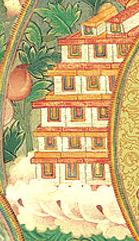Dharma

Dharma (Skt.; Tib. ཆོས་, chö, Wyl. chos) — the word used to refer to the teachings of the Buddha (Skt. Buddhadharma). It has many shades of meaning, including ‘the spiritual path’, or ‘spirituality’ in general. It also refers to phenomena, meaning things and events. See also ten meanings of Dharma.
Subdivisions
Dharma of transmission
The Dharma of transmission (Skt. āgama dharma; Tib. ལུང་གི་ཆོས་, Wyl. lung gi chos) consists of the three collections (pitaka): Vinaya, Sutra and Abhidharma.
Dharma of realization
The Dharma of realization (Tib. རྟོགས་པའི་ཆོས་, tokpé chö, Wyl. rtogs pa'i chos) is the threefold higher training:
- The training in higher discipline, which is the subject matter of the vinaya collection.
- The training in higher meditation, which is the subject matter of the sutra collection.
- The training in higher wisdom, which is the subject matter of the abhidharma collection.
Jikmé Lingpa said that if you understand that meaning of a single verse, that constitutes the Dharma of scripture or transmission, and if you give rise to a virtuous mind for just an instant, that is the Dharma of realization.[1]
Eight Qualities of the Dharma
According to Maitreya's Uttaratantra Shastra, the Dharma has eight qualities of cessation and the path:
Path:
- 1) purity, since free from emotional obscurations
- 2) clarity, since free from cognitive obscurations
- 3) remedy, since it overcomes both obscurations
Cessation:
- 4) inconceivable, since beyond concepts
- 5) utterly peaceful, since it is free from karma and disturbing emotions
- 6) unfathomable, since individually cognized
And
- 7) cessation; and
- 8) the path.
Notes
- ↑ tshigs bcad gcig gi don shes na/ de ni lung gi bstan pa yin/dge sems skad cig skyes pa na/ de ni rtogs pa’i bstan pa yin.
Further Reading
- A Treasury of Dharma, aka The Mengak Study Pack (Lodève: The Tertön Sogyal Trust, 2005), pages 29-33.
- Khenpo Ngawang Palzang, A Guide to the Words of My Perfect Teacher (Boston & London: Shambhala, 2004), pages 107-108.
- Thinley Norbu, The Small Golden Key (Shambhala Publications, 1999), ‘10. The Dharma of Precept and Dharma of Realization.'